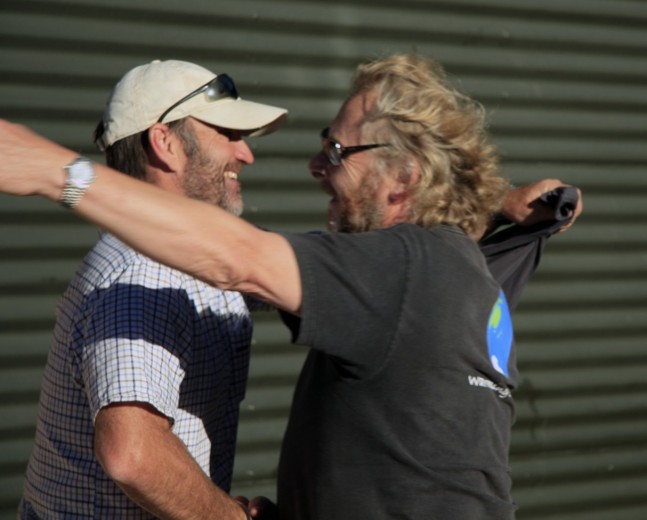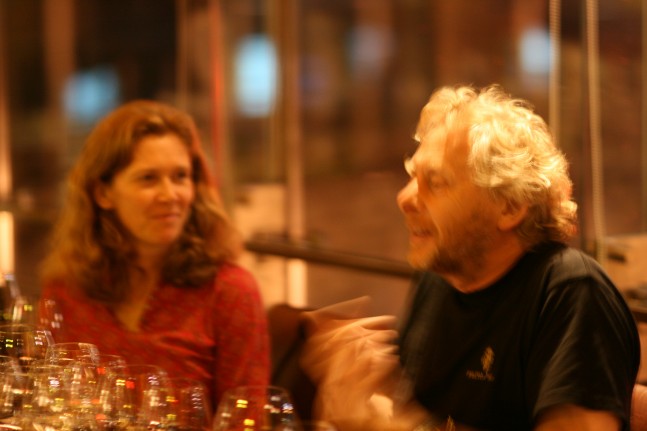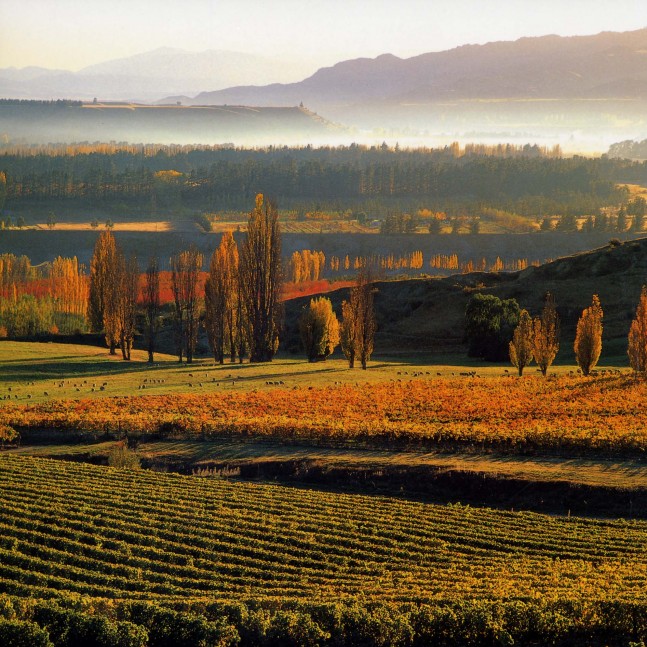Highlighting Felton Road as my Biodynamic Vigneron of the Lunar Year (Rabbit) encompasses acknowledging the hard toil of Felton Road viticulturist, Gareth King, and winemaker, Blair Walter; their implementation and day-to-day painstaking work in managing an organic vineyard and a property that fully embraces biodynamic principals is commendable with Felton Road the benchmark for New Zealand vignerons.

Gareth King, Viticulturalist at Felton Road and proprietor Nigel Greening celebrate the end of vintage
The nucleus of biodynamics is understanding and continuously observing and learning about the ecosystem and biodiversity of your property as a whole, adapting and developing solutions to enhance your agriculture or viticulture without any pesticides, herbicides or artificial fertilisers. In many respects it is laborious, although in time, the property as a whole evolves to be more and more self-sustaining—naturally. It is not a panacea to all aspects of viticulture or the challenges that occur with climate conditions throughout the year and vintage; it is however a strategic science of soil, both in the pedology (formation, chemistry, morphology and classification of soil) and edaphology (influence of soil on organisms, especially plants) and yet ironically we know more about the sea and marine life and organisms than we do about soil biology.
It is perhaps the mystery of soils biology that drives Felton Road’s proprietor, Nigel Greenings obsession with biodynamics, in a way extension of his intellectual fascination of the (scientific) unknown. He is in a sense, at the forefront of a new frontier of discovery and too his vineyard team (and many others) the leading spiritual and professional advisor on the subject. Greening is also one of the most compelling orators on biodynamic philosophy, actually he’s one of the few people I have come across who can cut through the compost and explain such a complex and intricate subject without getting too metaphysical or hippie-emotional. He can do biodynamics for dummies as convincingly as he can present a paper at a biodiversity and climate-change conference—to which Greening has generously allowed me to reproduce a fascinating and profound speech that he delivered on the subject at the World Climate Conference.
Beside the fact this speech is far more compelling than anything I could write on Felton Road and biodynamics, I am positive after reading it even the most cynical will be believers, and surely the sceptics who dismiss the practices of biodynamics cannot ignore the consistent quality and complexity of Felton Road wines as compelling evidence of the benefits of holistic farming.

Nigel Greening in animated discussion with Veronique Drouhin-Boss - its difficult to get Greening on film as he rarely stays still long enough for the lens
“Biodynamics is a mindset, not a religion or a recipe.” Monty Waldin
In discussing Biodynamics, we can do this in a number of ways. We could discuss the Steiner lectures that began it all in 1924, but I feel these are not a helpful way to create clarity. Too many people take these lectures almost literally, forgetting that, like all presentations, like this one I am making now, in fact, it is of its time, its place and its audience. Those original lectures, like Biodynamics itself, were something that had resonance at a time and a place. We are in another time and very much another place, so we need to allow for that change.
I can talk about what we do, but that focusses on an individual idea, not on the broader ideas. So let me turn to analogy and the core of the idea.
Take a healthy coral reef. Some of you may have had the pleasure of observing one first hand, I’m sure we all have seen them often in wildlife programmes. A coral reef is a wonderfully intricate ecosystem, where hundreds of species, many thousands of individuals, all co-exist in a single dynamic system. Although individuals are born and die, eat and are eaten, the overall system continues largely unchanged and is amazingly stable. The actors change, but the play remains the same. Nothing maintains this garden, nobody weeds it, trims it, fertilises it… it completely self manages, and, as long as nothing comes along to interfere, it will continue to do so for a long time to come. The same is true of a rainforest, or indeed any mature ecosystem. The hedgerows around my old farmhouse in Devon England are many hundreds of years old and you can age a hedge by its biodiversity: it takes about 500 years to become fully mature, then self manages.
These systems are technically called dynamic systems. That means that they are systems constantly in change, things are moving, evolving, never static. A second important term: they are non-linear. This is a technical term, but what it means is simple: they never repeat. Ever. This is self evident: you can take a picture of a coral reef , and leave the camera there. You could wait until the end of time and you would never be able to take exactly the same picture, with each creature in the same place. So this is a system of perpetual change in detail, but great stability in general. It has that stability because of its complexity; every opportunity on the reef is exploited by something. There are no major unoccupied niches. There is very little of what we call disease, because disease is held in check by competing micro-organisms that prevent any individual organism from gaining an overwhelming critical mass, which is normally the trigger for disease. It is kept healthy by the continuous competition at every level in the system.
The last technical bit, now. We often talk about systems like this having cycles. They don’t. A cycle repeats and, as I’ve just demonstrated, this never repeats. So no cycles, but there are rhythms. I call them rhythms because they have a tempo and they often almost repeat, but with a subtle variation. These rhythms in the ecosystem are mostly related to cycles of the planets, satellites and stars. The first and most obvious rhythm is the day: 24 hours created by our planet spinning on its axis, but the length of each day and night changing with the seasons. Then the tides; every 12 and a half hours the tides flow in and out as the earth spins relative to the moon, and this rhythm has probably been encoded into much DNA for billions of years as have the second and third lunar rhythms, the 27 day cycle of the moon around the earth and the synodic cycle: which is the 29 1/2 day period of the phases of the moon: full moon happens every 29 1/2 days. Corals, incidentally use this cycle to time their mating. Corals don’t have calendars and mobile phones, so they all need to be synchronised to a single outside system, so they release eggs and sperm on the same night; they use the Synodic cycle of the moon to do this.
Then we have the year, the cycle of our orbit around our nearest star: the sun. Beyond that there will be other rhythms, some unique to a species, others more general, some exquisitely subtle, others forceful. Examples include the El Nino, La Nina rhythm, where the pacific currents switch, changing much of the world’s weather as they do so, sunspot rhythms and so on and so on. Many biodynamic producers place great emphasis on the astrological calendar. I personally think that if there is an influence here, it is not the most interesting to explore, there are other, deeper and more significant tempi.
I now want you to try a mind experiment. Imagine we could float, with our masks and snorkels, along the surface of the soil of our vineyards, and look down through the transparent soil at all that is happening beneath us. What would we see? Well, it would be a lot less colourful, and much of it would be a great deal smaller, but the same structure would be evident: a complex ecosystem of thousands of creatures, from the microscopic upwards, all interacting in a fascinating dance following rhythms… some rhythms we can readily spot… others harder to understand. Suddenly, from this perspective, a lot of what we do becomes clear. Anybody who looks in awe at a coral reef would never think of squirting poison at it, hurling fertilisers onto it: it would be obvious that the effects would be devastating, far reaching, irreversible and incalculable and the idea that one might be able to affect one thing while the system carries on unchanged would obviously be ridiculous.
Contrast this to a typical farm. The farmer has stripped the existing ecosystem from the land, killing much of what lived there naturally, then planted a monoculture in its place. The damage he does leaves huge gaps of opportunity in the wrecked ecosystem and all sorts of creatures, great and small, head in to plunder the opportunities of the battlefield the farmer has created. So we quickly see weeds, often monocultures themselves, as the first in grows and takes over. We see disease, fungal plagues, sudden explosions in the population of insects, all eager to do battle for dominance in this new opportunity, with the farmers crop the biggest opportunity for them all to target.
And so the war starts. The farmer looks to win by killing the pests and diseases, but as fast as he kills, he opens up the system to new gaps and opportunities for mayhem. Growing a crop becomes a war with nature.
Biodynamics is about one simple idea: rather than have the war, can we understand the process of the dynamic system of our land, and if so, can we work with it, rather than against it to grow our crops?
In order to do this we have to consider three things: first, how to create a complex system in our farm, building the maximum biodiversity at every level from the microbial up to the top of the food chain.
Second, we have to remember that disease is imbalance. A little of anything is OK: you can even live your life in a healthy and happy way with a few thousand HIV viruses in your body. It takes a critical mass to turn them into a force for disease. So the best way to combat disease is not to simply kill it, but to look for ways for the dynamic to create natural competition to keep it in check.
Third, we have to try to understand the rhythms of our dynamic system. Careful observation of our land and everything that grows in it helps reveal the beat of the drums. If we gain insights into the rhythms of our farm, we can create opportunities, understanding better when to sow, or reap, when to water, when to add compost, when to trim and so on.
It isn’t crazy, any of it. Yes, it involves seeking to understand the forces driving the living system that we form a partnership with. Yes, it involves seeking to feel the rhythms of the dynamic nature of our land.
That does make it subtle, it is at times as much intuitive as it is analytical. But it doesn’t make it weird.
So what do we do?
By definition, the vines we plant are an imposition upon the ecosystem. That isn’t, of itself, that unusual, after all nature produces forests and grasslands with dominant species within them. But we have to try to ensure we can use every opportunity to add biodiversity into our vineyards. That begins at a microbial level, indeed the majority of all biodynamic farming concerns itself with the production of composts.
Composts perform two duties: for many growers they are principally a natural source of growth nutrients to plants: nitrates, phosphates and so on. Vines don’t need this so much, indeed they do well in “poor” soils, so we are principally using compost for its ability to bring microbial diversity with it into the soil and to provide a food source to the thousands of small creatures, from the microbial and fungal level up through various worms, insects and so on, that inhabit the soil. The very heart of biodynamics is to turn our soils into coral reefs of life and biodiversity.
People make much issue of the Biodynamic preparations. These were suggestions made by Steiner for creating teas with which to dress compost. Some people ascribe near magical qualities to them, but it is important to note that they are nearly all ferments of one sort or another and ferments create microbes. They thus have the role of building microbial biodiversity in the composts. Much is also made of the very small amounts used, but you only need to add a fraction of a gram of a microbe to a suitable growing medium to create huge amounts of it. We make wine and I frequently point this out: just a speck of saccharomyces yeast added to a tank of grape juice creates the most astonishing change!
The composts form the understory of our biodiversity, and to those we add cover crops. Everywhere we can, between vines, on spare land, we grow dozens of companion crops, each playing a part in building the ecosystem. The pattern is fascinating: we grow buckwheat which hosts a predatory wasp which lays its eggs in leaf roller caterpillar: a common vine problem. They then want a place to leave their egg implanted caterpillar. So we grow Triticale wheat, which has many benefits of its own, but when we cut the wheat, the holes in the wheat stubble are just the right size for the wasps to store their eggs.
We observe how each action starts a chain in the ecosystem. A couple of years ago, we started planting peas among the other seeds between vines. Peas are good for the soil, but I actually wanted a few pea pods and shoots growing, so we could pick them for lunch and workers in the vines could grab a snack as they labour. Within a year, we had pigeons in the vineyards, though we had never seen a pigeon there before. Pigeons love peas. Within months of that, the rare New Zealand Falcon became a frequent visitor, hunting pigeons. Now at harvest we always have an issue with birds that eat grapes, so by timing peas to be growing at harvest we can bring in a natural airforce to scare the birds away.
We do the same with another hawk: The Australasian Harrier. This eats carrion, so shooting a few rabbits and leaving their bodies around the vineyard builds a population of patrolling Harriers.
I could list many of these sorts of chains, but you get the idea: as you start to learn to understand the dynamics of your ecosystem you can turn them to your advantage. The last aspect of biodynamics I’d like to discuss is the philosophy that a farm should be able to be self contained. We follow this as far as we can, using spare land to grow vegetables, fruits and nuts, we have wonderfully prolific mushrooms, because of the composting philosophy, we have chickens living in the vines and providing eggs, a herd of goats keep the weeds and brambles under control in our hills, so there is space for grass to grow and feed our Highland cattle. If the older rabbits get to feed the hawks, the younger ones feed us, as do hares on the high slopes and the occasional wild deer.
From this we make food for our team to eat at lunchtime and special occasions. The inherent respect for everything in our vineyards, including those that work there, the way people are valued and share in the bounty of our land creates a strong demand among viticulturists around the world and we have many, many applications from very highly motivated and qualified people for each vacancy in our vineyard. A consequence of biodynamics that goes to the very head of the foodchain in our ecosystem.
You may have noticed in all this that I have not said anything about the wine being better. Wouldn’t that be the most important part? I cannot answer that as we have never kept land and treated it to chemical farming for research comparison. To me, that would be almost immoral. But it doesn’t matter. We do think our vines show greater health, greater resilience to difficulties of the season, but even if the wine were no better, this would still be the only way to make it for us. Once you start to make the whole system work, start to get an insight into the extraordinarily complex dynamic ecosystems at work, it would be impossible to ignore them and turn back.”
Nigel Greening, Proprietor and Vigneron, Felton Road , Central Otago, New Zealand
For more on Felton Road, visit their brilliant website www.feltonroad.com
For more Wandering Palate Felton Road articles, visit the links below:
Meet Kaz, the New Zealand Falcon: Felton Road’s new bird deterrent system for the 2013 vintage – click here
The Perfect Match – Nigel Greenings favourite Goat recipes and Felton Road Cornish Point Pinot Noir – click here
New Zealand Red Wine of the Lunar Year (Dragon) & Biodynamic Vigneron of the Lunar Year Felton Road Cornish Point Pinot Noir 2011, Central Otago, New Zealand – click here

Felton Raod Elms vineyard
|
|
Tweet |






No comments to Must-Have Wine – Biodynamic Vigneron of the Lunar Year Felton Road, Bannockburn, Central Otago, New Zealand | Comments Feed
No comments yet
The comments are closed.